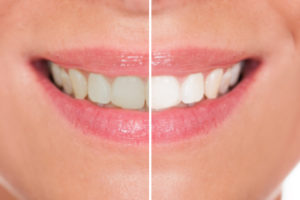 The FDA explains that “bleaching” is indicated for use when teeth retain the ability to be whitened beyond their natural color. Included in this category are products containing different bleaching agents like hydrogen peroxide or carbamide peroxide. “Tooth whitening”, by contrast, is the restoration of the natural color of the teeth by removing debris and removable stains. This is exactly why many of the “over the counter” advertised whiteners are permitted to utilize the term “whitening” when in fact it is a bit of a misnomer and the advertised results can be a bit misleading.
The FDA explains that “bleaching” is indicated for use when teeth retain the ability to be whitened beyond their natural color. Included in this category are products containing different bleaching agents like hydrogen peroxide or carbamide peroxide. “Tooth whitening”, by contrast, is the restoration of the natural color of the teeth by removing debris and removable stains. This is exactly why many of the “over the counter” advertised whiteners are permitted to utilize the term “whitening” when in fact it is a bit of a misnomer and the advertised results can be a bit misleading.
Types of Tooth Stains
Concerning teeth there are two different variations of stains and they are intrinsic stains and extrinsic stains.
- Intrinsic stains; This type of stain forms on the inside of the teeth. The etiology of this staining comes from trauma, tetracycline use during development, aging, and ingestion of fluoride in excess. While these stains in the past were considered permanent now we know that whitening can reduce the stains or completely eliminate them.
- Extrinsic stains; These stains are located on the outer layers of the tooth. They originate from drinking certain beverages, cigarettes, and normal wear and tear. Often these stains cannot be removed by just brushing and whitening can make significant impacts.
What Causes Staining?
Trauma
Impacts and injuries can cause fracture lines in teeth. These cracks can accumulate debris that often will discolor the teeth.
Age
Age correlates directly with tooth discoloration. Teeth are more susceptible to whitening procedures at earlier ages.
Tooth thinness and translucency
Some people have teeth have enamel coating (the outer hard highly calcified layer in teeth) that is thinner and more translucent than others. A thicker and more opaque tooth can be whitened more efficiently and effectively. Genetics determine much of this from patient to patient. Transparency is one of the few situations in which whitening is not effective. Speak to your dentist and he can tell you if you will see results.
Tobacco use
The use of tobacco can significantly stain teeth. These stains are often difficult to remove. The nicotine leaves deposits in tooth structure. These deposits slowly soak in and stains the teeth.
Diet
Certain foods have the ability discolor the natural teeth. Teas, red wine, coffee, colas, and other colored foods can stain teeth. In addition to this, erosion from certain foods with higher acidities will wear down the enamel coating and allow the yellow dentin to show through.
How Does Tooth Whitening Work?
Teeth can undergo this discoloration over time. The outer layer of the tooth is termed enamel. Enamel is semi-translucent, crystalline, and porcelain-like. Over time two major events can occur that will discolor the teeth. First, the enamel is not a regenerative material. It is avascular and not innervated. Because of this the enamel wears away to a certain extent over time and the layer directly underneath called dentin can become visible. The dentin has a yellow coloration to it. Additionally there are microfractures in the enamel that happen over time and have the possibility to fill with debris. This will further discolor the tooth. Whitening can possibly eliminate the coloration in the stains in these fractures and the teeth will appear whiter.
What is the Procedure?
A custom fitting tray made by the dentist is placed over the patient’s teeth. A small amount of the dispensed whitening gel is then placed inside the tray and remains there for the allocated time. The tray is custom developed by impressions that are taken of your teeth. While often results can be observed in a few days, it generally takes one to two weeks to see the full whitening potential in your teeth. It is important to observe that this is not a permanent procedure and periodic “touch ups” should be done to maintain the optimal whitening quality.
What Products do We Use?
White & Brite™ whitener, the first at-home tooth whitening system, is available in 10%, 16%, 22% and 30% carbamide peroxide strength kits. Deluxe Kits, Express Kits, Touch-Up Twin Packs in various strengths, and single syringe packages in 30% strength offer a wide array of professional options for any patient’s tooth whitening needs. All strengths have a pleasant mint flavor
Ponte Vedra Complete Dentistry is located in Ponte Vedra, Florida serving Ponte Vedra, Nocatee, Jacksonville, Jacksonville Beach, and Palm Valley. PVCD practices “complete dentistry” and offers services including but not limited to emergency dental care, veneers, implants, crowns, dentures, tooth whitening, pediatric dentistry, sleep apnea, root canal treatment, and treatment of gum disease.
If you have any questions or would like to schedule a consultation, please call us at (904) 285-7711 or contact us online.



